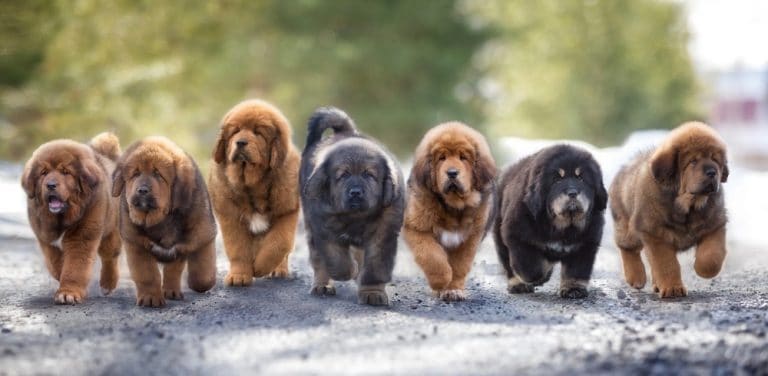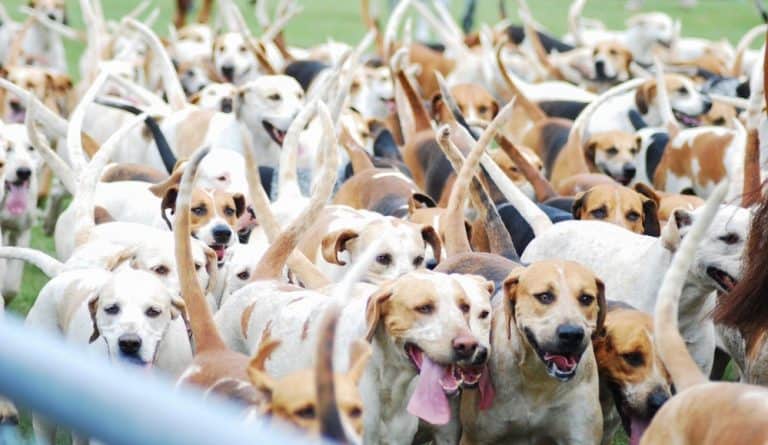Bull Terrier Weight Chart – Size & Growth Chart
Bull Terriers are strong, stout, and lovable dogs that belong to the terrier group. A Bull Terrier weight chart will be able to help you predict the size of your Bull Terrier puppy.
This breed was first bred to control vermin and for dogfighting in the European 19th century period. They are a tough and solid breed that fits in well with the family as long as they are properly trained at an early age.
You can know the Bull Terrier from its characteristic egg-shaped head. they also have pointed ears along with a convex nose Bridge.
Bull Terriers usually have shorts coats that are low shedding and white in color sometimes with large patches.
They have a comical and sometimes mischievous personality and many dog owners consider them endearing and playful. Since they are muscular they need a lot of exercise and love to enjoy playtime with their favorite humans.
When Is A Bull Terrier Fully Grown?

Standard Bull Terriers are seen as medium-sized breeds but the Miniature Bull Terriers fall into the miniature breed group.
Smaller dogs obviously have a different timeline for adulthood since they usually have less growing to do and therefore require less time to do it.
However, you will find that your Miniature Bull Terrier will take a bit longer than other small breeds to reach their full size. This is usually achieved in 11 to 12 months of age, while other breeds only take 6-8 months.
Standard Bull Terriers are seen as full-sized adults when they have reached the period of 1 year to 14 months old. That said, you may find that they would continue to add muscle until they are 2 years of age.
Also, note that when it comes to male and female Bull Terriers there has been no evidence to show that males attain adulthood before females, which is typically the case.
Each dog should be taken on an individual basis as many factors decide his size.
Bull Terrier Weight Chart
To predict the size that your Bull Terrier will be in the future or should be right now, we have compiled a Bull Terrier growth chart so that you can reference it. It will show estimated sizes for your Bull Terrier.
Please note that there are many reasons for your Bull Terrier being a certain size which include the food you give him, the exercise he is engaged in, as well as his genetics. Because of this, it may be impossible to precisely predict weight.
To use the chart, you must know his exact age, so that you can look on the chart and make a comparison of your dog’s weight based on what is listed on the chart.
If you notice that the figures are off by a few pounds then there is no need to overly concern yourself.
If you are not sure, and you are worried about your Bull Terrier then the best thing that you should do is visit a veterinarian.
Bull Terrier Puppy Weight Chart
| Age | Weight (kg) | Weight (lbs) |
|---|---|---|
| 3 Months | 8 - 14.3 kg | 17.6 - 31.5 lbs |
| 4 Months | 10.8 - 19 kg | 23.8 - 41.9 lbs |
| 5 Months | 13 - 23.1 kg | 28.6 - 51 lbs |
| 6 Months | 14.7 - 26.7 kg | 32.5 - 58.9 lbs |
| 7 Months | 16.5 - 30 kg | 36.3 - 66.1 lbs |
| 8 Months | 17.8 - 32.5 kg | 29.2 - 71.6 lbs |
| 9 Months | 18.4 - 34.2 kg | 40.5 - 75.4 lbs |
| 10 Months | 18.7 - 35.8 kg | 41.2 - 78.9 lbs |
| 11 Months | 19.1 - 37 kg | 42.1 - 81.5 lbs |
| 12 Months | 19.4 - 37.8 kg | 42.8 - 83.2 lbs |
Bull Terrier Growth Chart – What To Expect
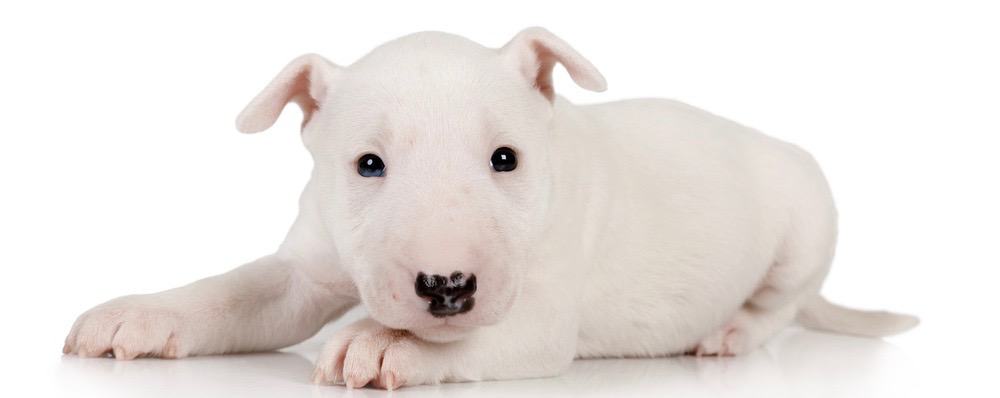
Birth – 2 Weeks
Bull Terriers are usually born into litters that have about 5 pups on average. They will be tired and sleeping most of the time.
When they are not sleeping they will be close to their mother gaining warmth from their littermates and the mother. They will also grow a lot during the stage, but they are not yet able to walk, but they can smell and taste their mother’s milk.
3 Weeks – 12 Weeks
Typically, Bull Terriers will be weaned during this stage. So watch out for the major changes that are taking place as your Bull Terrier begins to gain sight and the walk.
He will be interested in solid foods even though he may still be nursing from his mother. Do your best to make this transition as easy as possible by feeding your dog foods of the right consistency.
Commercial kibble may be a bit too hard for them at this time, so it is up to you as his owner to make sure that it is at the right consistency by adding liquids to it. At the end of this stage, they will usually be between 8 and 14.3 kg.
4 Months – 9 Months
By this time your Bull Terrier should be accustomed to solid foods and have a healthy appetite. Make sure that you feed him that is a healthy diet, high in protein.
He also needs healthy fats and dietary fiber so that we will have good digestion. Your Bull Terrier will continue to grow at a rapid pace as long as he is properly nourished. You can expect that he will weigh between 14.7 to 26.7 kilograms.
10 Months – 18 Months
A standard Bull Terrier will usually obtain his full size during this period, but he will be filling out when it comes to muscle.
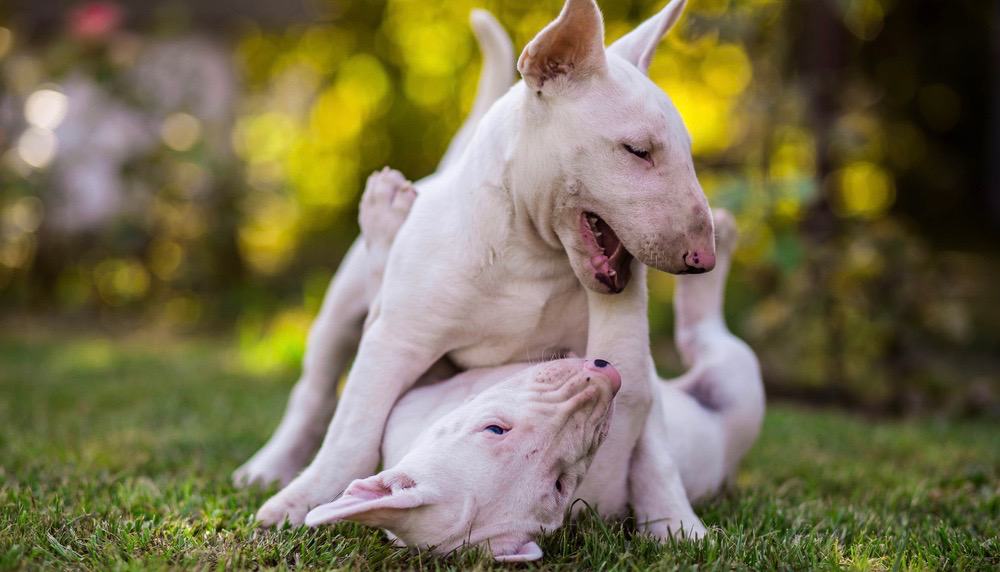
He will also be maturing mentally, so you should have been engaged him in some form of training.
This is best at younger ages, but it is not too late at this time because Bull Terriers are intelligent and eager to please their humans see. They should weigh around 19.4 – 37.8 kg.
Adult
Your Bull Terrier will be still filling out even though he was seen as an adult at the last stage of his development. He will look less like a puppy and more like an adult dog.
You still need to take special care when you are feeding him because he needs nourishment that will allow him to gain muscle as well as to have strong bones and teeth.
Also, make sure to engage him and exercise so that he can be healthy and strong
How Big Do Bull Terriers Get?
Male and female Bull Terriers are the same height and their standard size is usually about 21 to 22 in at the shoulder, but their weight is a bit different. Females usually weigh around 50 to 60 lb, but males are usually 60 to 70 lb.
To predict how big your Bull Terrier will become, you should look at their parents to get an idea. They would usually be the average weight of both parents.
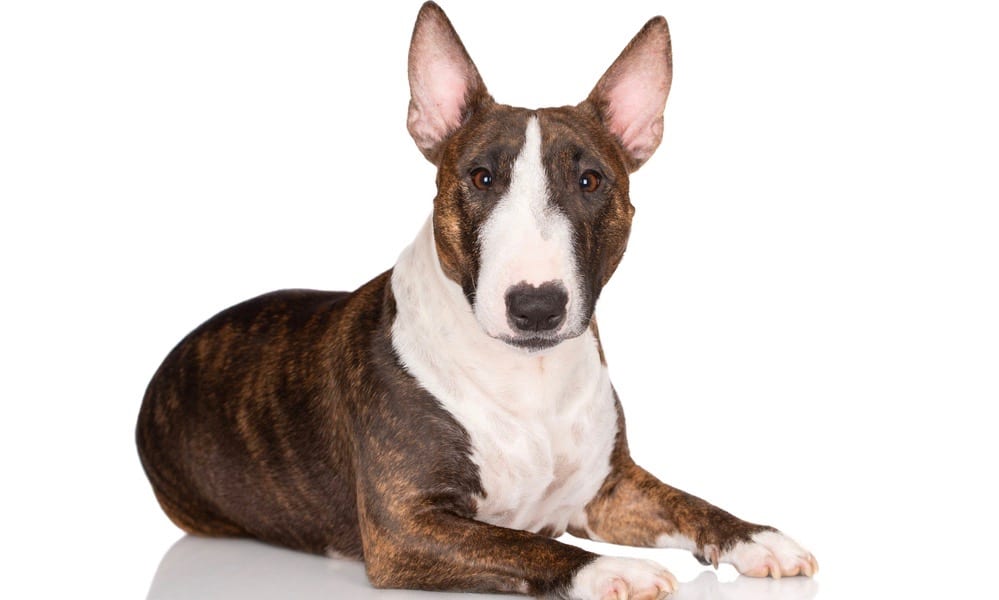
You may also look at their paws because when a dog has more growing to do, you will notice that their paws are a bit larger than their body.
DNA tests may also be helpful in learning the genetic makeup of your dog since many dogs are not purebred. This may adjust your calculations when trying to discover what their weight will be.
Will Neutering/Spaying My Bull Terrier Affect His Growth?
The best time to neuter or spay your Bull Terrier is when they have attained adulthood which is around 14 months. This will ensure that they have reached a certain level of development so that spaying or neutering will not negatively affect them.
With females, you should pay special attention to them because they may have mated and would be pregnant way before this time.
First pregnancies are always tricky and do affect a dog’s health if not properly have handled. Immature dogs will not be able to properly take care of puppies.
Usually, male Bull Terriers are aggressive toward other animals when they are not neutered. They tend to be more aggressive to other dogs in particular.
Training and proper socialization are necessary if you want your Bull Terrier to have better behavior around other animals when you realize you do not want to neuter them.
Bull Terrier Size Chart
Bull Terriers Usually stand at a height of 18 to 22 in with a weight of 45 to 65 pounds in adulthood.
Usually, the dogs tend to be more on the heavier side, but the difference is insignificant so each dog should be taken case by case regardless of gender.

Dogs are measured by the withers which are the highest point of their shoulder blades.
To measure your dog, you need to have him stand up straight and use your measuring tape to measure from the floor straight up to his withers then record this height.
Pitbull vs Bull Terrier Size
When it comes to the size of Pit bulls or Bull Terriers you should know that Pitbulls are a bit larger and tend to be a bit more aggressive.
Bull Terriers are more compact and small. Additionally, we cannot forget the miniature Bull Terriers which would obviously be much smaller than the Pitbull.
These are two muscular dog breeds, but they have different appearances. As mentioned before the Bull Terrier has an egg-shaped head. They are both dogs blue enjoy time with their owners and lots of physical activity to maintain their muscles.
Factors That Affect Bull Terrier Growth
Genetics & Gender
Male and female Bull Terriers are usually around the same height, but the weights differ only slightly in the male’s favor.
The amount is insignificant, so it is not mentioned for the most part. Biology affects the way animals grow including growth spurts. The parents are usually a big part of finding out the way your Bull Terrier will grow including any hereditary diseases.
Nutrition
You should only give your Bull Terrier food that is of high quality, whether you are preparing it at home or you purchase commercially made food.

Whatever you decide you must feed them a diet high in animal protein that is appropriate for their age. During development higher levels of protein are needed. You can level this out as they get older.
Seniors require less food overall because they are usually last active, and you do not want them to gain weight.
Physical Activity & Health
Try to give you a Bull Terrier daily exercise in moderate amounts to maintain his physical health. This also helps his mental health because time outdoors spends with his favorite humans makes him happy.
You will find that your Bull Terrier is agile and loves to be active daily. Long walks are ideal but do not overdo exercise as you can affect the joints.
What If My Bull Terrier Is Not The Right Weight
Bull terriers usually do not have issues with their joints unless they get some injury from too much exercise.
But you should try to avoid having them grow too quickly because this can place pressure on their undeveloped joints causing issues later on in life. You can avoid this by feeding them the proper food at the right time.
If commercial food is what you decide to feed your Bull Terrier then you must understand that it should be high-quality kibble that lists protein as the first ingredient.
They should be on puppy food until they are about 1 year old, but you can talk to your veterinarian about when is the best time to start giving them adult food.
You will know that your bull terrier is undernourished if you can see protruding ribs see. If you run your hands along his rib cage and cannot feel his ribs then you know he is overweight, and you should adjust his diet immediately.
How Much Does It Cost To Own A Bull Terrier?
If you want to own a Bull Terrier then you should go to a responsible breeder, or you can adopt. To purchase a Bull Terrier you may pay around $815-$2,000 and an average price of $1,500.
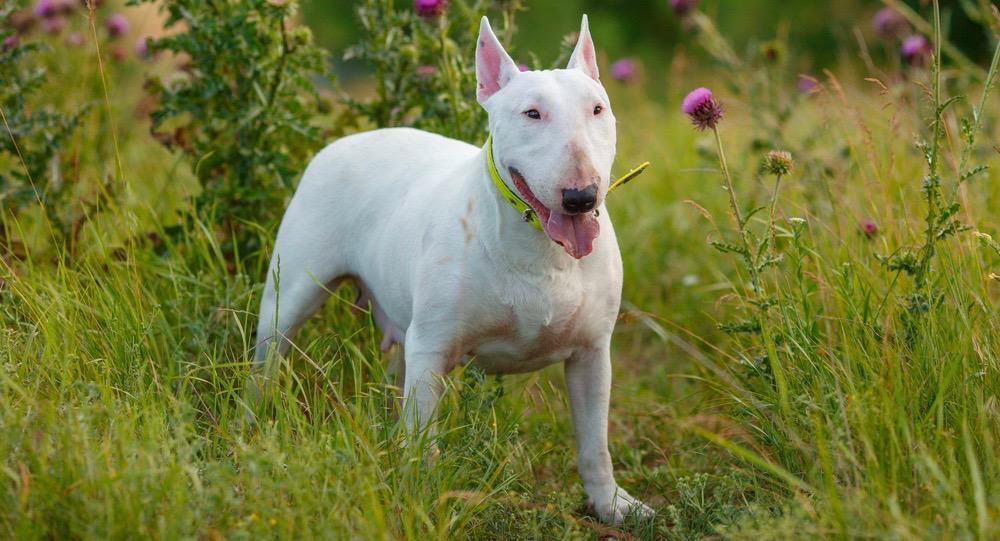
You should expect that the amount you will spend on your Bull Terrier in the first year of his life will be approximately $4,590 and about $1,635/year every year after that.
These will cover all of your dog’s needs and wants like food, grooming, treats, medical appointments, Licenses, microchip insertion, insurance, sending him to a boarding facility, and any other miscellaneous costs
Bull Terrier Genetics And Common Health Problems
The most common health problem that Bull Terriers face, based on their genetics is problems with their hearing. You should have your puppy tested for his hearing before you purchase him from any breeder.
They also can suffer from kidney and heart disease so have them checked for that as well. As with most dogs, they may have problems with their growth plates during their development so keep this in mind.
You should also look to your veterinarian for more guidance on how to take care of your Bull Terrier’s health so that you may make the right decisions.
Typically, health clearance may not be delivered to dogs who are younger than 2 years old because some problems take a while to manifest.
Final Words
Do your best to make sure that your Bull Terrier puppy is properly trained at a young age. This will save you a tremendous amount of trouble later on in his life.
The amount of food you should give your Bull Terrier should be determined by his build, age, size, level of activity, and metabolism.
Typically, when they are adult age, you can feed them twice per day with high-quality dog food. They should have around 3-4 cups of dry food per day.
Always monitor them to make sure they are not getting overweight. If you put these measures in place, you are likely to have a healthy, and loyal companion.

